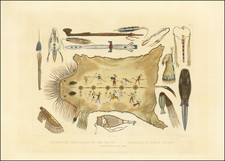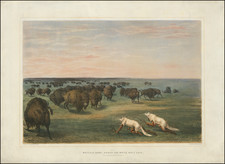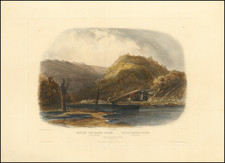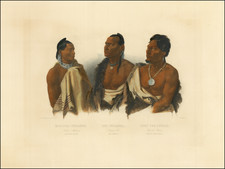Indians Hunting the Bison, an exquisite aquatint, etching, and roulette by Karl Bodmer, represents a dynamic portrayal of a buffalo hunt, evoking the drama of the Plains Indian way of life in the early 19th century. This hand-colored tableau, heightened with gum arabic, originated from Bodmer's expedition with Prince Maximilian during which, near Fort Union in 1833, they witnessed the intricacies of buffalo hunting practices.
The significance of bison hunting to Native American tribes and its eventual representation in European art is of historical interest. During the 19th century, the bison was not merely a symbol of the vast American landscape but an essential part of the indigenous tribes' sustenance, economy, and cultural practices. Karl Bodmer, traveling with Prince Maximilian, was privy to firsthand accounts and depictions of these hunts, most notably the Mandan tribe's methods of hunting bison on horseback, where hunters approached their quarry to a close range before releasing their arrows.
However, Indians Hunting the Bison transcends mere ethnographic documentation. The tableau draws inspiration from multiple sources, highlighting Bodmer's interaction with the artistic milieu of his time. Paintings by George Catlin, which hung in the St. Louis home of Benjamin O'Fallon, and works by Peter Rindisbacher, a pivotal figure introducing a wider audience to the American West, possibly influenced Bodmer's rendition. Key elements, such as the scattering of bison on the terrain, the poised Native Americans on horseback, and the nuanced depiction of the hunting dynamics, evoke comparisons with Catlin's and Rindisbacher's interpretations.
The tableau further illustrates Bodmer's artistry and capacity for synthesizing observed details with existing artistic motifs. While the tableau pays homage to the traditions and aesthetics of both Catlin and Rindisbacher, it stands unique in its emphasis on the central figure's anatomy and the momentum of the hunting scene. The interplay of movement and intensity suggests that Bodmer's work, despite its European genesis, retains an authenticity born of immersion in the landscapes and cultures of the American frontier.
In a world where the line between documentation and interpretation is often blurred, Indians Hunting the Bison stands as a testament to the artistic endeavors that aimed to capture the essence of Native American life, while simultaneously reflecting the influences and interactions of a globalizing artistic community. The tableau immortalizes a crucial aspect of indigenous history and showcases the cross-cultural dialogues shaping 19th-century art and ethnography.
State
Ruud's 1st (of 2) states, lacking the date.









![[ Florida Indians - Preparations for a Feast ] Conviviorum apparatus](https://storage.googleapis.com/raremaps/img/small/98462.jpg)




![[ Death of a Florida Indian Chief ] Ceremoniae in Regis & Sacerdotum funere observatae. XL.](https://storage.googleapis.com/raremaps/img/small/97768.jpg)